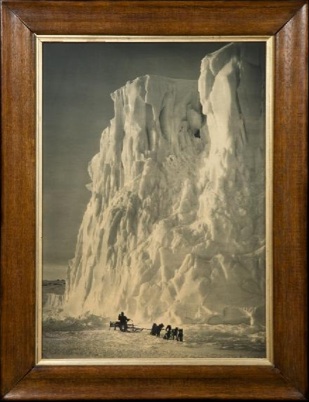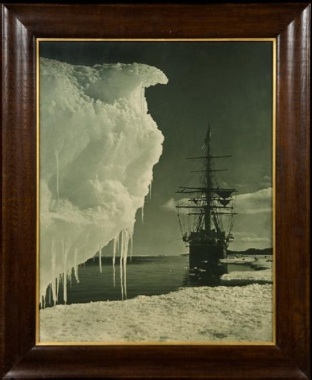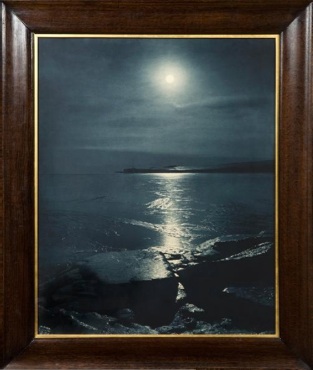Great Scott – rare original 1913 polar photographs from Captain Scott’s infamous expedition to the Antarctic on sale for the first time in a century
23 February – 5 April, ATLAS Gallery, 29 Dorset Street, London, W1U 7NF
IMAGES: http://bit.ly/atlasgallery
- The Great White South: A new exhibition of rare antique polar photographs - the first prints made from the negatives in 1913- taken by “Scott of the Antarctic’s” official expedition photographer, Herbert G. Ponting.
- Last on public view in 1913, this is the largest collection of Ponting’s original carbon prints assembled for nearly a century.
- Opportunity for collectors to purchase these rare antique photographs. Items priced from £12,000 - £27,000
- A NEW limited edition collection of 48 contemporary platinum reprints of Ponting’s photographs also available, published in a special portfolio, priced at £25,000, individual prints from £800.
- Exhibition will also include The Lost Photographs of Captain Scott, taken by Scott himself during his ill-fated trek to the South Pole
The ATLAS Gallery, Marylebone, will unveil a major collection of rare vintage photographs – the original prints taken from the negatives in 1913 - by Herbert G. Ponting, the official expedition photographer of the infamous British Antarctic “Terra Nova” Expedition to the South Pole, lead by Captain Robert Falcon Scott between 1910–1912. In total over 50 images by Herbert Ponting and Captain Scott will be on display. Image library: http://bit.ly/atlasgallery


The unique selling exhibition - The Great White South - will offer collectors the opportunity to purchase these valuable antique Carbon Print Photographs, which range in price from £12,000 - £27,000 [Full Price list below].
The original 1913 carbon prints on display, which are in exceptional condition, have not been exhibited publicly for nearly 100 years, and many remain in their original Edwardian frames. The ATLAS Gallery show is the largest exhibition of Ponting’s original Polar photographic prints assembled since first being displayed at the Fine Art Exhibitions between 1913 and 1915.
Herbert G. Ponting (1870-1935) was already one of the most renowned and accomplished photographers of his day when he was recruited as a ‘camera-artist’ to document Scott’s attempt to reach the pole. A highly experienced travel photographer, his photographs of Japan, Burma and China - taken before his journey to Antarctica - are still highly sought after by collectors today. Among his most collectable and rarest works are his photographs of the Antarctic, taken during the Terra Nova Expedition.
The ATLAS Gallery’s selling exhibition is from the collection of antique photography collector Richard Kossow, who started collecting Ponting’s polar photographs over 25 years ago. Kossow, a Literary Dealer, had his interest in Ponting’s photography sparked through his research into the diaries and memoirs of the Edwardian Polar explorers. After finding many of Ponting’s original prints in appalling states of decay, he devoted his collecting towards finding Ponting’s best-preserved original photographs, wherever possible in their original frames. These museum-quality works are exclusively represented by the ATLAS Gallery.
Ponting’s extraordinary visual record of the Polar regions are considered to be of huge scientific and visual significance. His extraordinary technical and compositional talents captured images of the previously uncharted continent of unparalleled quality, which are still among some of the finest ever taken of the Antarctic. Ponting was the very first professional still and movie photographer to go to a polar region, and was the first movie cameraman to use his camera for naturalist studies. The photographs are also of considerable artistic note, displaying both the typically painterly compositions indicative to Edwardian photography, but also highly innovative, almost modernist perspectives on the polar landscape, demonstrating Ponting as a creative and pioneering photographer.
Additional works exhibited at the Great White South Exhibition:
Limited Edition Platinum Print Portfolio
In addition to the collection of the original carbon prints produced in 1913, there will also be a new limited edition collection of 48 platinum prints, published in a special portfolio in association with the Scott Polar Research Institute, Cambridge, available for purchase. Handmade from Ponting’s original negatives, the prints will be exhibited with specially commissioned essays by experts including author and explorer Sir Ranulph Fiennes, which provide a fascinating insight into the incredible story behind these remarkable photographs. The platinum print portfolios are priced at £25,000 for the complete portfolio with individual prints from around £800.
The Lost Photographs of Captain Scott
The exhibition will also feature the Lost Photographs of Captain Scott, taken by Scott himself during his tragic march to the Pole and first exhibited at the ATLAS Gallery in November 2011. Throughout his polar trek, and in the face extreme arctic weather conditions, Scott – trained by Ponting – captured some breathtaking polar panoramas as well as photographing the explorers themselves, documenting some of the most poignant and emotive records of the fateful expedition.
The collection of images, of which the works on display are modern limited edition reproductions of the original prints, chronicling the first part of Scott's Antarctic journey, were thought lost for almost 70 years because the negatives had been misplaced and the prints were in private hands. When the collection resurfaced at a New York auction in 2001, they were bought by Richard Kossow who had planned to sell them on until they were bought by the Scott Polar Research Institute with help from the Heritage Lottery Fund for the British Nation.
Ben Burdett, Founder and Managing Director of the ATLAS Gallery said: “Ponting’s photography of the Antarctic had a tremendous impact when it was first displayed at the Fine Art Exhibitions in 1913 that is often difficult for a contemporary audience to fully understand. There was a huge outpouring of national grief for the loss of Captain Scott and his party, and Ponting’s images of the expedition became a focal point for the general public to see for themselves where Scott’s remarkable story played out.
“The original show was also a pivotal moment in the history of photographic curation. The Fine Art Exhibitions were the biggest selling exhibition of photography ever staged at that time, and the scale of the photographic prints surpassed any previously displayed in public.
“The quality of preservation we see in the collection we have today adds to the value of these unique artefacts, and we are extremely excited to be hosting this selling exhibition at the ATLAS Gallery.”
Richard Kossow, assembler of the Ponting Collection said: “The history of exploration in the Antarctic is fascinating, but, until the advent of Herbert Ponting, poorly represented in its photographic documentation. Most photographic records from the "Heroic Age" of Antarctic expeditions are of frustratingly low quality, which is why I was initially drawn to the exceptional calibre of Ponting’s photographs.
“Aside from their scientific importance, the beauty and creativity of their compositions make them amongst some of the most captivating travel photography ever taken. As Naomi Rosenblum said in her World History of Photography, "it is not surprising that some of Herbert Ponting's images from Scott's Terra Nova expedition should recall the freshness of vision that characterised the first views of the western American wilderness". When considering the challenges to photography in the extreme Antarctic climate, their power and genius are even more impressive.
“I have committed 25 years to searching out the best-preserved prints the first showing at the 1913-14 Fine Arts Society's Exhibitions of Ponting's Terra Nova photographs and am delighted to be presenting this fine collection at the ATLAS Gallery”.
Captain Scott’s ill-fated polar trek remains imprinted in the public consciousness as the venture in which Scott was beaten to the South Pole by the Norwegian Roald Amundsen, only to perish during his return journey, along with four other members of the polar party.
The ATLAS Gallery’s exhibition will mark the centenary of the death of Captain Scott and his men, as well as the National Service of Commemoration in honour of Scott, which will be held at St Paul’s Cathedral, 29 March 2012.
- END -
For further information:
Kallaway PR:
- Maxim Bendall: Maxim.bendall@kallaway.com - 020 7221 7883
- Will Kallaway: William.kallaway@kallaway.com - 020 7221 7883
IMAGES: http://bit.ly/atlasgallery
Notes to Editors
Great White South – The Photographs of Herbert Ponting and Captain Scott
23 Februrary – 5 April
ATLAS Gallery, 29 Dorset Street, London, W1U 7NF
Opening Hours:
Mon – Fri: 10:00am – 6:00pm
Sat: 11:00am – 5:00pm
Sun: CLOSED
Listings Text
75 word listing:
The ATLAS Gallery unveils a major selling exhibition of rare prints – shown for the first time since they were first exhibited in 1913 - by Herbert G. Ponting, the official expedition photographer on the infamous “Terra Nova” Expedition to the South Pole, lead by Captain Robert Falcon Scott.
In addition the exhibition also features the Lost Photographs of Captain Scott, taken by Scott himself during his tragic march to the Pole.
55 word listing:
A major collection of rare photographs taken during the infamous “Terra Nova” Expedition to the South Pole, lead by Captain Robert Scott, are revealed and on sale for the first time in a century. Featuring photographs by Scott himself and Herbert G. Ponting, Scott’s official expedition photographer, it is the first time some images have been shown since 1913.
25 word listing:
Scott of the Antarctic’s ill-fated polar expedition is revealed through a selling exhibition of rare photographs, unseen for 100 years, by Herbert G. Ponting, Captain Scott’s official expedition photographer.
Price List: Herbert Ponting Carbon Prints:
Terra at the Ice-Foot, Cape Evans (16 January, 1911)
Large-scale vintage dark green-toned carbon print
Fine Art Society Label in original frame, superb original condition, without blemish.
Signed by blind-stamp in the image.
Image size: 73.5 x 57.5cm
Framed size: 92 x 75.5cm
£25,000
The Freezing of the Sea (April, 1911)
Large-scale vintage blue-toned carbon print
Fine Art Society Label, original frame, superb original condition, without blemish
Signed by blind-stamp in the image
Image size: 73.5 x 58.5cm
Framed size: 92 x 76.5cm
£18,000
Tabular Ice-Berg off Cape Royds (13 February, 1911)
Large-scale vintage light green-toned carbon print
Fine Art Society Label, original frame, superb original condition, without blemish
Signed by blind-stamp in the image
Image size: 57 x 73.5cm
Framed size: 75.5 x 92cm
£20,000
The Ramparts of Mount Erebus (1911)
Large-scale vintage light blue-toned carbon print
Fine Art Society Label, original frame, superb original condition, without blemish
Signed by blind-stamp in the image
Image size: 52 x 72.5cm
Framed size: 71 x 92cm
£23,000
Pancake Ice, (Cape Royds, 1911)
Large-scale vintage rich blue-toned carbon print
Fine Art Society Label, original frame, superb original condition, without blemish
Signed by blind-stamp in the image
Image size: 56 x 72.5cm
Framed size: 74 x 91cm
£24,000
The Terra Nova in McMurdo Sound (7 January 1911)
Large-scale vintage green-toned carbon print
Fine Art Society Label, original frame, superb original condition, without blemish
Signed by blind-stamp in the image
Image size: 57 x 73.5cm
Framed size: 74.5 x 91cm
£24,000
Midnight in the Antarctic Summer (30 January 1911)
Large-scale vintage rich blue-toned carbon print
Fine Art Society Label, original frame, superb original condition, without blemish
Signed by blind-stamp in the image
Image size: 56 x 72.5cm
Framed size: 74 x 91cm
£24,000
The Hut at Cape Evans (26 March 1911)
Large-scale vintage rich blue-toned carbon print
Fine Art Society Label, original frame, superb original condition, without blemish
Signed by blind-stamp in the image
Image size: 72.5cm x 56cm
Framed size: 91 x 74cm
£24,000
The Terra Nova in a Gale (December, 1910)
Large-scale vintage green-toned carbon print
Fine Art Society Label, original frame, superb original condition, without blemish
Signed by blind-stamp in the image
Image size: 56 x 72.5cm
Framed size: 74 x 91cm
£27,000
Captain Oates and Siberian Ponies (Terra Nova, 1910)
Vintage gelatin silver print print
In original frame, superb original condition
Signed and titled in ink in margin
Image size: 34.5 x 44.2cm
Framed size: 48 x 57cm
£15,500
Herbert G. Ponting
Herbert G. Ponting (1870-1935) was one of the most renowned photographers of his day when he was recruited as ‘camera-artist’ to the British Antarctic (Terra Nova) Expedition, 1910-1913.
Born into a wealthy Victorian family from Salisbury, Ponting worked briefly as a banker before moving to California and turning his attention to photography. During the first years of the 20th century, a number of assignments took him to the Far East. In 1904-1905, he photographed the Russo-Japanesse war in Manchuria, before continuing his travels in Japan, Burma, Java, China and India, selling his work to London’s foremost magazines. In 1910, he expanded his photographs of Japan into a book, In Lotus-Land Japan, which was published just before his departure for the Antarctic, and remains much sought after.
As a member of the Terra Nova Expedition, Ponting helped set up the Antarctic winter hut at Cape Evans on Ross Island, and was entitled to a tiny photographic darkroom in which he also slept. Working mostly with glass plate negatives, he set to work photographing all aspects of the expedition and of the environment around Cape Evans.
During the winter of 1911, he took many photographs of Scott and the other members of the expedition in their hut, producing images that speak to us both within and beyond their historical context.
With the start of the 1911-12 sledging season, Ponting’s fieldwork began to come to an end. As a middle-aged man, he was not able to take part on the inland trek to the South Pole, and after 14 months at Cape Evans he boarded Terra Nova in February 1912.
Ponting returned to London where he set to work shaping a visual narrative of the expedition for Captain Scott to show during his lectures upon his return. This was not to be, however, as Scott and four of his men perished on their return from the Pole.
The tragic outcome of the Terra Nova expedition would affect Ponting’s later life and career. Although they were much used, a prior contractual agreement with Scott did not guarantee Ponting any exclusivity in exploiting the photographs, and his own lectures earned him very little. Then, with the advent of World War I, the world suddenly had more pressing concerns than expeditions to the Antarctic. Paradoxically, Ponting’s most profitable venture was his book, The Great White South, a written account of his participation in the expedition.
Ponting virtually gave up photography, turning to business instead, but he was no businessman. He invested money in a number of ventures, only one of which was in his own field - a film printing company. They all failed.
When he died in 1935, the net value of his estate was insufficient to pay off his debts.
About the ATLAS Gallery
www.ATLASgallery.com
ATLAS Gallery was founded in 1994 by Director and owner Ben Burdett.
Originally located in the Hoxton neighbourhood of London during the late 1990’s, the gallery became a well-known exhibition space in the heart of London’s new and vibrant contemporary art scene. In 2001 ATLAS moved to its present location in the centre of London and has, over the last decade, become one of the foremost galleries in London dealing exclusively in fine art photography.
ATLAS Gallery hosts approximately six exhibitions per year. The gallery specialises primarily in classic and modern 20th Century vintage photography, photojournalism and fashion photography, in addition to representing work by a number of important contemporary photographers. In 2005 ATLAS became gallery agent of Magnum Photos, representing all Magnum photographers in the United Kingdom and Internationally.
The gallery is both active in encouraging work by young artist and photographers, and assisting collectors to come into closer contact with these works. The gallery works actively with private clients and corporate collections to assemble important and unique art collections, as well as being actively involved in the acquisition of exceptional modern and contemporary works by many museums and public collections world-wide.
- END TO ALL -





